International
Brazil February inflation rate hits seven-year high

AFP
Brazil’s inflation rate hit a seven-year high for the month of February, the government said Friday, as hefty fuel-price hikes took effect that will only exacerbate surging prices, a sore spot for President Jair Bolsonaro.
The monthly inflation rate for February in Latin America’s biggest economy came in at 1.01 percent compared to January. This was the highest for the month of February since 2015, said national statistics institute IBGE.
The annual inflation rate rose 0.16 point to 10.54 percent, it said.
That remains far above the central bank’s target of 3.5 percent, defying the bank’s efforts to rein in prices with one of the most aggressive series of interest-rate hikes in the world.
With the Russia-Ukraine war now pushing prices even higher worldwide, Brazil’s inflation problem is only expected to get worse — especially after state-run oil company Petrobras announced it would hike gasoline prices by 19 percent and diesel by 25 percent from Friday over the fallout of the Ukraine crisis.
“Higher fuel prices are likely to push the headline (inflation) rate up even further in March, to above 11 percent,” William Jackson, chief emerging markets economist at Capital Economics, said in a note.
“While the central bank’s monetary policy committee hinted at its last meeting that the tightening cycle was nearing an end, the worsening inflation outlook is likely to keep it in a hawkish mood.”
Brazil’s central bank has raised the key interest rate from an all-time low of two percent in March 2021 to 10.75 percent currently.
But the massive hikes have yet to bring down soaring prices, which are hurting Brazilians’ wallets and Bolsonaro’s popularity as he fights an uphill battle to win reelection in October against leftist ex-president Luiz Inacio Lula da Silva, his likely opponent, who currently leads in the polls.
International
El Chapo’s son Joaquín Guzmán López pleads guilty to U.S. drug trafficking charges

Joaquín Guzmán López, one of the sons of notorious Mexican drug lord Joaquín “El Chapo” Guzmán, pleaded guilty on Monday to drug trafficking charges in a U.S. court, months after his brother Ovidio reached a similar plea agreement, according to local media reports.
The defendant appeared before a federal court in Chicago early Monday afternoon and changed his previous plea in the case, the Chicago Tribune reported. U.S. authorities accuse him of forming, together with his three brothers, the cartel faction known as “Los Chapitos.”
The group is believed to have continued the operations of El Chapo, who has been serving a life sentence in the United States since 2019.
Guzmán López, 39, was arrested after landing in Texas in a small aircraft alongside cartel co-founder Ismael “El Mayo” Zambada.
International
Venezuela authorizes return flights as U.S. continues deportations amid rising tensions

The arrival of U.S. aircraft carrying undocumented Venezuelan migrants continued regularly despite rising tensions between Washington and Caracas over President Donald Trump’s military deployment in the Caribbean.
Trump maintains that the deployment is part of an anti-narcotics operation, while Venezuelan President Nicolás Maduro insists the true objective is to remove him from power and seize the nation’s oil resources.
Venezuela’s aviation authority has “received a request from the United States government to resume repatriation flights for Venezuelan migrants from that country to Venezuela,” the Ministry of Transportation said in a statement .
“Under the instructions of President Nicolás Maduro, authorization has been granted for these aircraft to enter our airspace,” it added.
Caracas will permit two Eastern Airlines flights to land on Wednesday and Friday.
Migration remains one of the Trump administration’s flagship issues. On Monday, the U.S. president held a meeting with his National Security Council to discuss the situation in Venezuela, a day after confirming he had spoken with Maduro by phone, without offering further details.
According to the Venezuelan government, roughly 75 deportation flights have been carried out this year, returning at least 13,956 Venezuelans from the United States.
International
20,000 rounds stolen from german army after driver leaves cargo unattended

The German army confirmed the theft of a shipment of ammunition that occurred a week ago while it was being transported by a civilian delivery driver, a military spokesperson told AFP, confirming earlier media reports.
According to Der Spiegel and the regional broadcaster MDR, around 20,000 rounds of ammunition were stolen from an unguarded parking lot near Magdeburg, in eastern Germany, while the driver was asleep in a nearby hotel. No information has been released regarding the identity of the suspects, and the military declined to specify the exact type or amount of ammunition taken.
Authorities have also not indicated how the perpetrators knew the cargo would be left unattended.
“The theft was discovered upon delivery at the barracks,” the German army spokesperson said.
A police spokeswoman confirmed to AFP that an investigation has been opened but refused to provide further details “for tactical reasons.”
Sources close to the German military, cited by Der Spiegel, believe it is unlikely the theft was a coincidence. They suspect the thieves waited for the driver to stop for the night before striking.
Der Spiegel also reported that the Defense Ministry normally requires two drivers for this type of transport to ensure the cargo is constantly monitored. However, in this case only one driver was assigned, meaning the civilian transport company failed to comply with the security protocols.
-

 Central America4 days ago
Central America4 days agoTrump Pardons Former Honduran President Hernández and Warns of Aid Cuts Ahead of Election
-

 Central America2 days ago
Central America2 days agoHonduras Extends Voting by One Hour Amid High Turnout, CNE Announces
-

 International1 day ago
International1 day agoHong Kong police arrest 13 over deadly high-rise fire that killed 151
-

 Central America3 days ago
Central America3 days agoHonduras’ China–Taiwan Future Hinges on Sunday’s Presidential Election
-

 International4 days ago
International4 days agoMeta Says Russia Seeks to Ban WhatsApp for Defending Secure Communication
-

 International1 day ago
International1 day agoSri Lanka and Indonesia deploy military as deadly asian floods kill over 1,000
-

 International1 day ago
International1 day agoTrump says asylum decision freeze will remain in place “for a long time”
-

 International1 day ago
International1 day agoChile enters runoff campaign with Kast leading and Jara seeking a last-minute comeback
-

 International7 hours ago
International7 hours ago20,000 rounds stolen from german army after driver leaves cargo unattended
-

 International7 hours ago
International7 hours agoVenezuela authorizes return flights as U.S. continues deportations amid rising tensions
-

 International7 hours ago
International7 hours agoTrump convenes National Security Council as U.S.–Venezuela tensions intensify
-

 International7 hours ago
International7 hours agoEl Chapo’s son Joaquín Guzmán López pleads guilty to U.S. drug trafficking charges






























